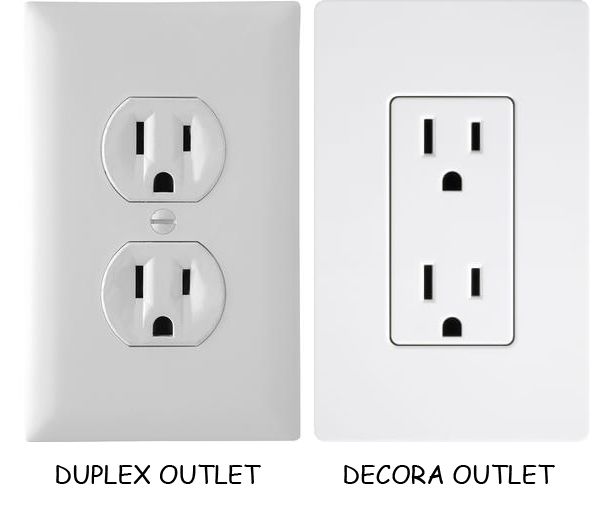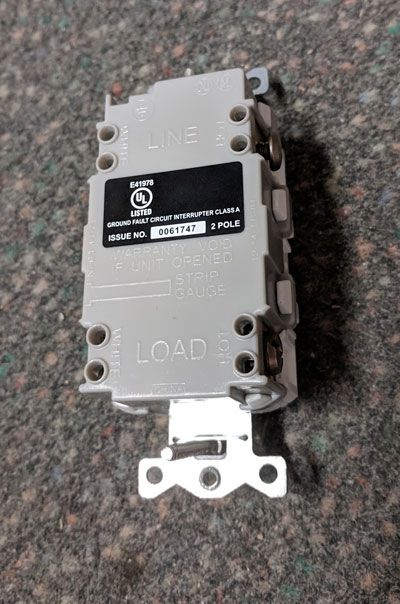Troubleshooting
If you are working on electrical, always turn the power off. Electricity can cause serious injuries, burns, and death.
If you are working on electrical, always turn the power off. Electricity can cause serious injuries, burns, and death.
Switch and Outlet Styles
Switches and outlets come in MANY different styles and colors these days. There are tons of colors and styles available. Shown in the pictures are the most common styles to help you identify what you have. If we can identify what is in your home or office, we can try to send our electricians with the correct material and save time and money.
If you are looking for something a little different, please give us a call. There are outlets with USB ports built in... even different kinds of USB ports like USB-A and USB-C. There are even lighted outlets so the holes where the cord goes glows!
What is a GFI outlet? How do they work? Where are the usually located?
A "ground fault circuit interrupter" or GFCI outlet monitors the electrical current flowing through both the "hot" conductor and the neutral conductor. If the current flowing through both wires is more than approximately 5 milliamps different, the outlet "trips" and shuts off.
GFIs are typically located in kitchens, garages, bathroom, and outdoors. The National Electrical Code specifies many places that they are required.
Each GFI is different. The GFI shown, has a red light and the reset button pops out when the GFI has tripped. When in doubt, push the test button, and then the reset button. Sometimes you have to push kinda hard, and use a pencil or something because the button may have to be pushed well into the face of the device to reset it.
A single GFCI outlet can protect an entire group of outlets. The image of the back of the GFI shows the "line" and "load" terminals of a GFI. Power comes into the "line" terminals and any outlet "downstream" can be connected to the "load" terminals and protected by the same GFI. This is important because when troubleshooting outlets that aren't working in your home, you may have to check other rooms. For example, it is common to have a GFI in a bathroom, and use it to protect another bathroom. So if an outlet isn't working in the downstairs bathroom, the GFI in the upstairs bathroom may need reset. Or if an outlet outside your home isn't working, a GFI in your garage may need reset.
Update: Recent changes to GFI outlets have made it so that a GFI outlet will not reset without power. If you are working on a GFI outlet, and it is tripped but it will not reset, the power could be off. It could be a bad GFI outlet or the breaker could simply need reset.
Breakers. What do they do? Why do they trip?
Breakers are designed to protect the wiring and equipment connected to them. Typically, a breaker trips for a reason. Resetting a breaker several times is usually not a good idea. Unplugging appliances is the first place to start, but if you can't find why a breaker is tripping please give us a call. As winter sets in, many people get out electric space heaters. While these are useful, please be careful about the fire hazards. Usually an electrical circuit can only handle one average space heater. Plugging in several heaters on the same circuit is asking for tripped breakers.
Breakers do get old and weak. If a breaker has been heavily used, like running a space heater, they can simply get weak and fail. Breakers may also trip sometimes almost out of the blue. Having to reset a breaker one time that seems to have tripped for no reason is usually not a bad sign.
So, how do you reset a breaker. Here you can see an image of an electrical panel in a house. Both vertical rows of breakers have the handles pointed to the center of the panel. This is most commonly the ON position. Breakers have small, difficult to read letters that indicate the ON and OFF positions. When a breaker trips, the handle is supposed to flip to the center position. To reset it, you simply push the handle fully OFF and then back ON.
Some breakers have a "window" that turns orange when the breaker is tripped. The image above shows this "window".
One troubleshooting tip - sometimes a breaker can trip, but not flip to the tripped position. One quick way to check is to gently run your finger down the breakers, slightly pushing them toward the OFF position. If a breaker is TRIPPED, but didn't flip to the tripped position, gentle pressure will cause the handle to flip to tripped and reveal the problem breaker. Now you can push it fully OFF and back ON.

If you are troubleshooting a power loss in a room or part of a room, it could very well be caused by a "stab-in-the-back" outlet. The best thing to do is start with the outlet that you use the most, or where you plug in your vacuum cleaner. Plug something in to your most used outlet and wiggle the plug gently and see if everything comes back on. If it does, replace the outlet.
#2 The code now requires "tamper resistant" outlets in many places. In the image on the left, you can see the outlet on the right has plastic "guards" inside that covers the metal contacts. These guards are the same as the child proof outlet plug covers. The trick with these covers are that the little covers inside only move out of the way if both of them are pressed at the same time. So if you are having trouble plugging something into a tamper resistant outlet, make sure you aren't plugging in at an angle. Sometimes these little guards can really do their job well, so don't be afraid to wiggle the plug and push a little more than gently.
#3 In our GFI section above we discussed how GFI outlets work and some places they are required. In the image on the left, the white outlet on the left has a "WR" stamp. This means the outlet is "weather resistant". Any outlet installed outdoors is now required to be weather resistant.








